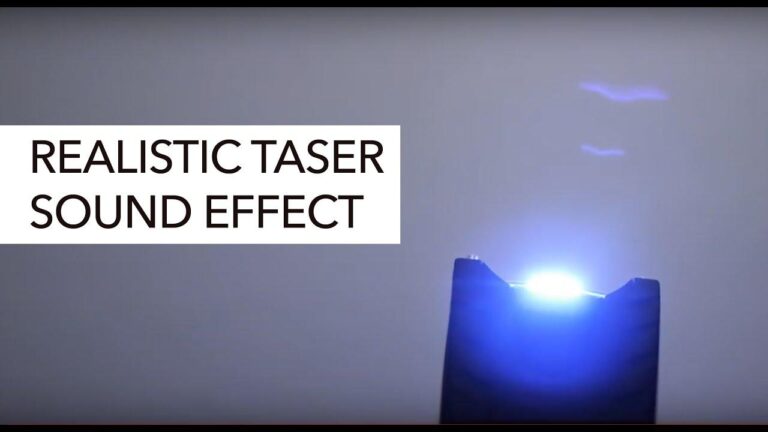Table of Contents
- Common Causes of Unusual Sounds in Stun Guns and What They Mean
- The Role of Electrical Components in Stun Gun Noise Production
- Safety Tips for Handling a Stun Gun that Makes Strange Noises
- When to Seek Professional Inspection or Replacement for Your Stun Gun
- Closing Remarks
Common Causes of Unusual Sounds in Stun Guns and What They Mean
When a stun gun begins to emit odd noises, it often signals underlying issues that shouldn’t be ignored. One of the most frequent culprits is battery problems. A weakening or improperly seated battery can cause inconsistent power flow, leading to intermittent buzzing or crackling sounds. Additionally, moisture or dirt trapped around the electrodes can disrupt the normal sound pattern, producing unusual hissing or sizzling. These disruptions indicate that the stun gun’s electrical components are struggling to function optimally, and addressing these simple maintenance concerns can often clear the noise.
Another common cause lies in the device’s internal circuitry or aging components. Over time, the internal coil or transformers can start to wear out or become damaged, which manifests as a distorted or fluctuating buzzing noise. Some users also report clicking sounds when the stun gun’s safety switch or trigger mechanism develops mechanical tension. In these situations, it’s essential to inspect for physical wear or loose connections, as continuing to operate the device without repairs may compromise its effectiveness and safety. Regular checks and timely servicing can prevent these acoustic warnings from escalating into critical failures.
- Battery degradation or improper insertion
- Electrode contamination or moisture exposure
- Worn-out internal coils or electrical components
- Mechanical tension in switches or triggers
The Role of Electrical Components in Stun Gun Noise Production
At the heart of every stun gun lies a complex network of electrical components designed to deliver a powerful jolt while maintaining safety and effectiveness. The distinctive noise you hear is often a byproduct of how these parts interact. Key players include:
- Transformer coils: These convert the electrical energy into a high-voltage pulse, often producing a humming or buzzing sound.
- Capacitors: They store and release energy rapidly, causing subtle electronic noises during discharge cycles.
- Switching circuits: Rapid on/off electrical switching generates high-frequency sound waves captured as crackles or pops.
Understanding these components helps explain why the noise varies in pitch and intensity. It’s not just random interference; it’s the audible footprint of the stun gun’s internal electrical symphony performing its function.
Safety Tips for Handling a Stun Gun that Makes Strange Noises
When your stun gun starts emitting unusual sounds, prioritize safety above all. Never attempt to disassemble or investigate the device yourself, as internal components can pose electrical hazards. Keep the stun gun away from sensitive electronics and ensure it is switched off before inspecting it visually. If strange noises persist, store it in a secure, dry location away from children and pets, and avoid using it until it has been evaluated by a qualified professional.
Additionally, here are a few key safety reminders to follow:
- Do not charge the stun gun near flammable materials, as sparks or electrical malfunctions might ignite fires.
- Use only the recommended charger and follow manufacturer guidelines to prevent battery damage that could cause noises or overheating.
- Regularly inspect the exterior for cracks or damage, which could indicate internal malfunctions leading to unusual sounds.
- Consult professional repair services or replace the device if noise issues continue, as malfunctioning stun guns can be unsafe.
When to Seek Professional Inspection or Replacement for Your Stun Gun
If your stun gun begins to emit unusual noises such as persistent buzzing, clicking, or intermittent popping sounds, it could be signaling internal malfunctions that aren’t visible from the outside. Attempting to diagnose or repair these issues yourself can be dangerous due to the high voltage involved. It’s crucial to enlist the help of a qualified professional who can accurately assess electrical components, check for wear and tear, or identify any faulty circuits causing the noise. Ignoring these sounds may not only compromise the device’s effectiveness but also put your safety at risk during operation.
You should consider professional inspection or even replacement if you notice any of the following:
- Persistent or escalating noise patterns that don’t resolve after basic maintenance like battery replacement or cleaning.
- Physical damage or corrosion evident on the stun gun’s electrodes or casing.
- Failure to deliver consistent shocks or noticeable reduction in stun capability.
Addressing these signs promptly ensures your stun gun performs reliably and safely, keeping you protected when you need it most.
Closing Remarks
In conclusion, understanding why your stun gun makes strange noises is key to ensuring its proper function and your safety. From electrical discharges to mechanical components, these sounds often indicate normal operation but can sometimes signal maintenance needs. If you ever notice unusual or persistent noises outside the typical buzzing or crackling, it’s wise to consult the manufacturer’s guidelines or seek professional advice. Staying informed helps you use your stun gun confidently and effectively-because when it comes to personal protection, knowledge truly is power.Check Our Other Blogs
- StunGun – Your Trusted Source for Stun Guns, Laws, and Self-Defense Tips
- PepperSprayLaws – Your Trusted Resource for Pepper Spray Information
- StunGunLaws – Your Trusted Guide to Stun Gun Legality and Safety





